 Circa 5,000 produced, 18 models
Circa 5,000 produced, 18 models(civil war, interwar, WW2 and the cold war).
The start: From the Imperial Aviation

On May 30 1912, Vice-Admiral of the Imperial Russian Navy Alexander Karl Nikolai von Lieven in his report No. 127 proposed the creation of aviation detachments operating in close coordination with the three fleets (Baltic, Black sea and Pacific). Approved with reservations by the Naval Minister Vice Admiral Ivan Grigorovich it was reinforced later by MGSh No. 1706/272 on 06/02/1912 for the General Staff School, to start creating new infrastructures for naval aviation units in 1913. On 1st January 1913, the Emperor’s Military Air Fleet was created with its first seaplane and two wheeled airplanes for the Baltic fleet, five seaplanes for the Black Sea.
In early 1914, the Minister of the Navy started the creation of aviation department in the Naval General Staff while manufacturers were mobilized, specifications issued, for seaplanes built soon by Grigorovitch a well as various land-based fighters and reconnaissance. In fact in August 1914 it boasted the world’s largest air fleet followed by France, with 263 aeroplanes. During WWI, Russian Naval Aviation units from the Baltic and Black Seas were committed completely as the conflict started in the Balkans, against the Serbians. There were three dozen aircraft with 20 certified pilots when operations started. 10 seaplanes were patrolling the Baltic from Libau and 8 in the Black Sea, based in Sevastopol and Kilen Bay. Only a few went to the Pacific Ocean from the summer of 1915.
By early March 1915, 77 aircraft were in service, 47 for the Baltic, 30 for the Black Sea and soon three dedicated seaplane carriers in the black sea, the Orlitsa, the Imperator Nikolai I and the Imperator Alexander I, operating M-5 seaplanes, as well as the converted cruiser Almaz. The naval aviation section fought on in 1916 and until the revolution, but in the following chaos, all operations ceased.
Articles:
- Beriev BE-2 (1936)
- Beriev MBR-2 (1935)
- Chyetverikov MDR-6
- Polikarpov I-16 in Naval Use
- Shavrov SH-2
- Tupolev MR-6 (1932)
- Tupolev MTB-1 (1934)
- Tupolev TB-1P (1930)
Soviet Naval Aviation in the interwar
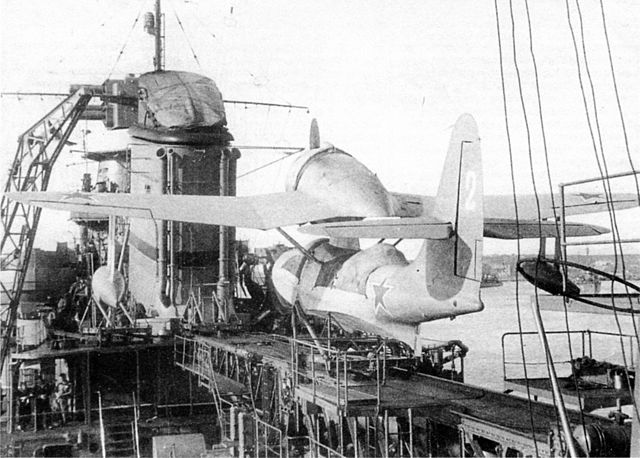
History
Soviet naval aviation (Morskaya Aviatsiya) was initially created under another name, in 1918: the Workers and Peasants Red Air Fleet. Prior to that, it inherited from the Emperor’s Military Air Fleet (1909–1917). This had oc creation of the “reds” participated in the Russian Civil War, cooperating with ships and army at Petrograd, on the Baltic and Black Sea, as well as over the Volga, Kama, Dvina rivers and Lake Onega. It was a hotchpotch of some 76 obsolete hydroplanes with poor maintenance and unskilled staff. Due to its condition it was used mostly for reconnaissance and supplies.
However when the Soviet Army and air forced consolidated in the 1920s, Naval Aviation started to increase in capabilities. Thanks to a first 5-year plan, it receive a massive influx of new reconnaissance hydroplanes, but also coastal defence bombers and fighters. By the mid-1930s, it grew so large that it needed to be separated, by creating at first the Baltic, Black Sea andt Pacific Fleet own naval aviation branches. In 1938–1940, Soviet Naval Aviation became a very important component of the Soviet Navy, with formations of torpedo and bomber planes. In the Great Patriotic War, the two combined Black sea and Baltic fleets had some 1,445 aircraft, most of these being the Beriev MBR-2.
The start: From the Imperial Aviation
 On May 30 1912, Vice-Admiral of the Imperial Russian Navy Alexander Karl Nikolai von Lieven in his report No. 127 proposed the creation of aviation detachments operating in close coordination with the three fleets (Baltic, Black sea and Pacific). Approved with reservations by the Naval Minister Vice Admiral Ivan Grigorovich it was reinforced later by MGSh No. 1706/272 on 06/02/1912 for the General Staff School, to start creating new infrastructures for naval aviation units in 1913. On 1st January 1913, the Emperor’s Military Air Fleet was created with its first seaplane and two wheeled airplanes for the Baltic fleet, five seaplanes for the Black Sea.
On May 30 1912, Vice-Admiral of the Imperial Russian Navy Alexander Karl Nikolai von Lieven in his report No. 127 proposed the creation of aviation detachments operating in close coordination with the three fleets (Baltic, Black sea and Pacific). Approved with reservations by the Naval Minister Vice Admiral Ivan Grigorovich it was reinforced later by MGSh No. 1706/272 on 06/02/1912 for the General Staff School, to start creating new infrastructures for naval aviation units in 1913. On 1st January 1913, the Emperor’s Military Air Fleet was created with its first seaplane and two wheeled airplanes for the Baltic fleet, five seaplanes for the Black Sea.
In early 1914, the Minister of the Navy started the creation of aviation department in the Naval General Staff while manufacturers were mobilized, specifications issued, for seaplanes built soon by Grigorovitch a well as various land-based fighters and reconnaissance. In fact in August 1914 it boasted the world’s largest air fleet followed by France, with 263 aeroplanes. During WWI, Russian Naval Aviation units from the Baltic and Black Seas were committed completely as the conflict started in the Balkans, against the Serbians. There were three dozen aircraft with 20 certified pilots when operations started. 10 seaplanes were patrolling the Baltic from Libau and 8 in the Black Sea, based in Sevastopol and Kilen Bay. Only a few went to the Pacific Ocean from the summer of 1915.
By early March 1915, 77 aircraft were in service, 47 for the Baltic, 30 for the Black Sea and soon three dedicated seaplane carriers in the black sea, the Orlitsa, the Imperator Nikolai I and the Imperator Alexander I, operating M-5 seaplanes, as well as the converted cruiser Almaz. The naval aviation section fought on in 1916 and until the revolution, but in the following chaos, all operations ceased.
(More to come)
Russian Imperial Naval Aviation
“Red” Naval Aviation in the civil war
In 1917-18, Russia lost advanced marine bases in the Baltic and Black Seas as well as the School of Naval Aviation in Baku. To add insult to injury, a fire in the Central Aviation Warehouse in Petrograd by 1917 led to the disparition of most documentation, technical equipment and aircraft useful to naval aviation. By mid-1918, the entire Russian naval aviation, one of the pride of the Tsarist regime, was mostly gone along with close to 150 seaplanes that were either destroyed, or passed on to the enemy. Only the Naval Aviation School in Oranienbaum survived as well as the Air Combat School in Krasnoye Selo, testing station and factory in Petrograd.
Plus the Civil War soon demanded an urgent mobilization and all personal devoted to the naval aviation, including officers, pilots and maintenance personal were now under arms. Some also took part in the river flotilla and only a few pilots left took provided air reconnaissance until the whole ensemble of remaining seaplanes and pilots were placed under the Supreme Military Council to the Naval Aviation Administration. It created a an air division in Oranienbaum and started to train fighter squadrons at the Air Combat School in Krasnoe Selo.

Red Army Aviation Barge “death”
Despite an acute shortage of material and resources naval aviation personnel grew and new units were formed soon assigned to various the fronts at Arkhangelsk and the Volga. Seaplanes greatly facilitated riverine and and lake reconnaissance for the advance of flotillas and were a boot for morale, and as it went, Russian “White” pilots until then mastering the skies machine-gunned any oppoitions, bombed shipping sometimes at very close range and altitude. But as the Red naval aviation was setup, they started to act more cautiously.
In the winter of 1918 was created a maritime air command consisting of two squadrons of floatplanes and one of fighter, and this organization was planned to be formed for each military flotilla. Though, the entire supply of seaplanes and a trained pilots was drained and the situation remained largely unfavorable, for organization and production. The new naval aviation school asked by many also failed to materialize. The aircraft factory in Petrograd was not in working conditions, with most assets dispersed or destroyed and without trained workforce whereas the Naval Aviation School of Nizhny Novgorod remained inactive, again fault of experienced pilots, having transferred most of its assets to the Volga division.
Despite very limited capabilities and insignificant resources, extraordinary efforts centered around the Baltic Fleet provide a starting point for resume production of new seaplanes at the Petrograd plant, and on Gutuyevsky Island plus a new test station and second decicated school. By 1 January, 1919, local engineers were able to assemble new seaplanes using remaining stocks of semi-finished or nearly finished models, cranking out some 30 Grigorovich M-9 type models. Eventually by the very end of 1919, the “red” naval aviation corps was strong of 52 seaplanes and 21 fighters.
This corps worked with the Red Fleet and Red Army and participated in the defeat of the White armies on the Northern and Petrograd fronts as well as being decisive on the Volga, the Caspian Sea, Lake Onega the Dnieper. Mechanics had to work wit a lack of spares in very difficuklt condition traying to maintain or repair Worn out engines, somle adting back to 1913, and an acute shortage of fuel. By desperations, the engines ran woth poor quality mixtures of different surrogates, which further aggravated the engine’s fatigue. Acute food shortages led flight crews to stay sustained on stale bread roasted on castor oil and having no proper flight clothing tried to use standard winter clothes, but this went to frozen injuries along the way. Enthusiasm however was not in shortage among naval aviation personnel, and missions were performed on a faily basis, whereas the White’s air supremacy started to greatly erode, to the point it vanished in 1920.
Combat activity had particular operational conditions and detachments performed a large array of missions from reconnaissance flights to bombing raids up to 18 aircraft, as well as regaining air supremacy. The northern front saw 345 hours flown, Petrograd 196, Volga 1200, Caspian Sea 435, Lake Onega 76, Dnepr 180 hours flown for more than 3000 combat hours, 32,8 tons of bombs, 1,6 tons of arrows dropped. By early 1920 the Northern and Eastern fronts became far more quieter and the Caspian flotilla managed to secure the Sea, the only front remaining being the Southern Front in Crimea, and Black and Azov Seas.
In Azov, the present flotilla secured the Kerch Strait despite loosing most of its assets due to poor maintenance. The Azov flotilla saw aerial reconnaissance provided by floatplanes vital in the 10 and 14 August battles at Krivoy and Obitochnaya Scythe. Over the Black Sea, aviation roamed over Kherson, Ochakov and Odessa with frequent raids on enemy shipping, with espacially hardcore combat at the Ochakov fortress. The artillery managed to reduced the fortress with accuracy thanks to the action of seaplanes acting as spotters, culminating with the 130 mm guns armed coastal batteries reduced to rubble by the 12-inch guns of Battleship General Alekseev. In early 1921, albeit the “red” naval aviation had been seriously reduced by constant combat, the fight was mostly won, and the basic organization was soon changed, infrastructure rebuilt in the next decade.
Soviet Naval Aviation in the interwar

History
Soviet naval aviation (Morskaya Aviatsiya) was initially created under another name, in 1918: the Workers and Peasants Red Air Fleet. Prior to that, it inherited from the Emperor’s Military Air Fleet (1909–1917). This had oc creation of the “reds” participated in the Russian Civil War, cooperating with ships and army at Petrograd, on the Baltic and Black Sea, as well as over the Volga, Kama, Dvina rivers and Lake Onega. It was a hotchpotch of some 76 obsolete hydroplanes with poor maintenance and unskilled staff. Due to its condition it was used mostly for reconnaissance and supplies.
However when the Soviet Army and air forced consolidated in the 1920s, Naval Aviation started to increase in capabilities. Thanks to a first 5-year plan, it receive a massive influx of new reconnaissance hydroplanes, but also coastal defence bombers and fighters. By the mid-1930s, it grew so large that it needed to be separated, by creating at first the Baltic, Black Sea and Pacific Fleet own naval aviation branches. In 1938–1940, Soviet Naval Aviation became a very important components of the Soviet Navy, with formations of torpedo and bomber planes. The Great Patriotic War the two fleets of the Black sea and Baltic combined some 1,445 aircraft, most of these being the Beriev MBR-2.
Soviet Naval Aviation in WW2
During the war, Naval Aviation provided air support to the Soviet Navy over the Barents sea, the Baltic and Black Sea as well as the Sea of Okhotsk.
It was composed almost exclusively of land and shore based planes, since the limited size of the Navy saw few ship-based planes in action: Thos of the three Gangut-class battleships, and about seven cruisers. Flying boats were of course the most recoignised asset of the Navy, using specific aircraft, while torpedo-bomber units relied on air force models, converted in some cases to carry torpedoes or equipped with floats. In some cases, transport plaanes of the Navy were used for land operations, in support of the Red Army during coastal offensives, but also landings and special wartime joint army-navy operations. Air cover to Allied convoys in North Sea and up to the Barents Sea was also one of its missions, as well as in the north Pacific and Sea of Okhotsk.
Naval Aviation was noted in the defense of Odessa in June–October 1941 (Crimean campaign) where naval troops were very active. The Black Sea fleet air arm also carried out many air strikes during the 1944 offensive. In terms of sunken ships it was quite successful, achieving a 2/3 better success ratio than any other unit of the Soviet Navy. In all, 17 naval aviation units were awarded the title of ‘Soviet Guards’ and 241 naval air personal were awarded the title of the Hero of the Soviet Union, some pilots twice.
Units:
-1st Guards Fighter Aviation Division VVS VMF
-2nd Torpedo Rananskaya Red Banner Aviation Division in the name of N.A. Ostryakova VVS VMF
-3rd Bombardment Aviation Division VVS VMF
-4th Bombardment Aviation Division VVS VMF
-5th Torpedo Aviation Division VVS VMF
-6th Bombardment Aviation Division VVS VMF
-7th Bombardment Aviation Division VVS VMF
-8th Torpedo Gatchinskaya Red Banner Aviation Division VVS VMF
-9th Assault Ropshinskaya Red Banner, Order of Ushakov Aviation Division VVS VMF
-10th Seysinskaya Red Banner Aviation Division of Dive Bombers VVS VMF
-11th Assault Novorossiysk Twice Red Banner Aviation Division VVS VMF
-12th Assault Aviation Division VVS VMF
-13th Aviation Division of Dive Bombers VVS VMF
-14th Mixed Aviation Division VVS VMF
-15th Mixed Aviation Division VVS VMF
-16th Mixed Aviation Division VVS VMF
List
- Grigorovich M-24 & M-24bis – coastal reconnaissance flying boat (1922)
- Tupolev MP-6 – twin-engine floatplane (1923)
- Grigorovich M-23 & M-23bis – single-engined training or reconnaissance flying boat (1923)
- Tupolev ANT-4 – twin-engine torpedo bomber floatplane version (1925)
- Shavrov Sh1 & Sh-2 – general-purpose amphibious flying boat (1929)
- Tupolev ANT-8 – twin-engine patrol bomber flying boat (1931)
- Beriev MBR-2 – short-range reconnaissance/bombing flying boat (1932)
- Tupolev ANT-22 – 6-engine, twin-hull flying boat (1934)
- Tupolev MTB-1 – trimotor patrol bombe flying boat (1934)
- Shavrov Sh-5 – twin-engined survey amphibious flying boat (1934)
- Chetverikov OSGA-101 – three-seat experimental amphibian (1934)
- Chetverikov SPL – two-seat submarine-borne reconnaissance flying boat (1935)
- Beriev KOR-1 (Be-2) – two-seat reconnaissance floatplane (1935)
- Shavrov Sh-3 – light transport amphibious flying boat (1936)
- Tupolev MTB-2 – 4-engine bomber/transport flying boat/amphibian (1937)
- Beriev MBR-7 – short-range reconnaissance/bombing flying boat (1937)
- Beriev MDR-5 – long-range maritime reconnaissance/bombing flying boat (1937)
- Chetverikov MDR-6 (Che-2) – three-seat coastal reconnaissance flying boat (1939)
- Shavrov Sh-7 – amphibious flying boat (1940)
- Beriev KOR-2 (Be-4) – two-seat reconnaissance flying boat (1940)
Models in detail
Floatplane/Seaplane models:
 Beriev MBR-2 (1931)
Beriev MBR-2 (1931)
1,365 built 1935-41
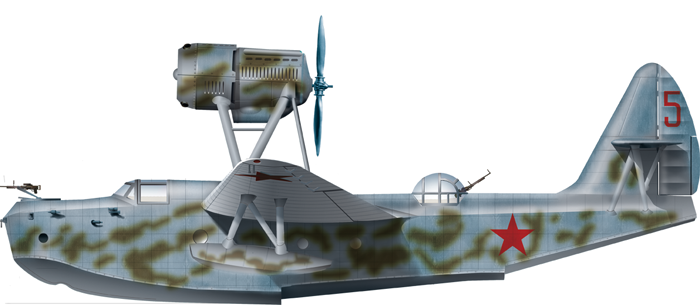
A well-known patrol multi-purpose flying boat which entered service with the Soviet Navy in 1935. Out of 1,365 built, 9 were exported, notably Finland and North Korea. It was nicknamed “Kорова” and “Амбар” and stayed the beast of burden of coastal patrols in WW2, with a production from 1935 up to 1941.
 Beriev BE-2 (KOR-1) (1936)
Beriev BE-2 (KOR-1) (1936)
12 built 1938
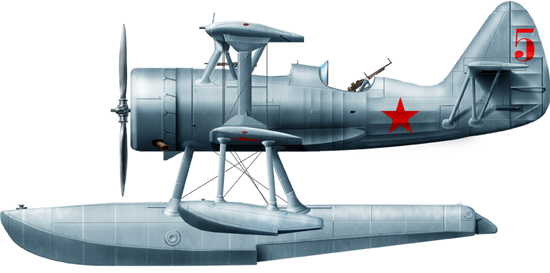
The small cruiser-based KOr-2 was the default observation plane in the Soviet Navy in the late interwar. This two-seat reconnaissance seaplane was designed to replace the Navy’s obsolete license-produced Heinkel He 55 and only 12 were delivered to the Navy for cruisers and battleships use, in service 1938-42.
 Beriev BE-4 (KOR-2) (1940)
Beriev BE-4 (KOR-2) (1940)
47 built 1941
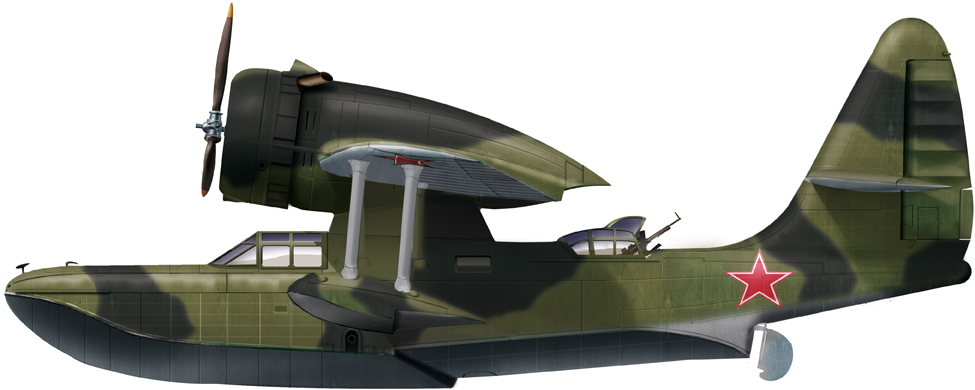
BE-4 at Krasnoyarsk Base, Siberia, fall 1944
The Beriev Be-4 was a reconnaissance flying boat built to operate from Soviet warships during World War II, logical successor of the BE-2. It was far more sturdy, faster, and has almost twice the range, but only 47 were delivered in 1941-42.
 Shavrov Sh-2 naval ambulance (1930)
Shavrov Sh-2 naval ambulance (1930)
circa 700 built 1933-39
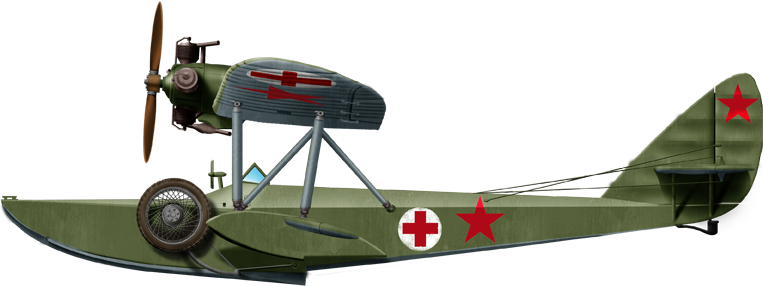
The Shavrov Sh-2 was a 1930s amphibian, first Soviet mass-produced flying boat. It could carry two crew members and one passenger, also equipped with skis in winter. Light, simple and reliable it was still in service in limited numbers out of a production of 700, in 1941 in roles such as flying ambulance, liaison, and training.
 Chetverikov MDR-6/Che-2 (1937)
Chetverikov MDR-6/Che-2 (1937)
27built 1939-41

The Chyetverikov MDR-6 was a late 1930s reconnaissance flying-boat aircraft. It was also the only successful aircraft designed by Igor Chyetverikov bureau. 27 were built from 1939 and it served until 1945.
 Ilyushin DB-4T (1936)
Ilyushin DB-4T (1936)
300? built 1938-44
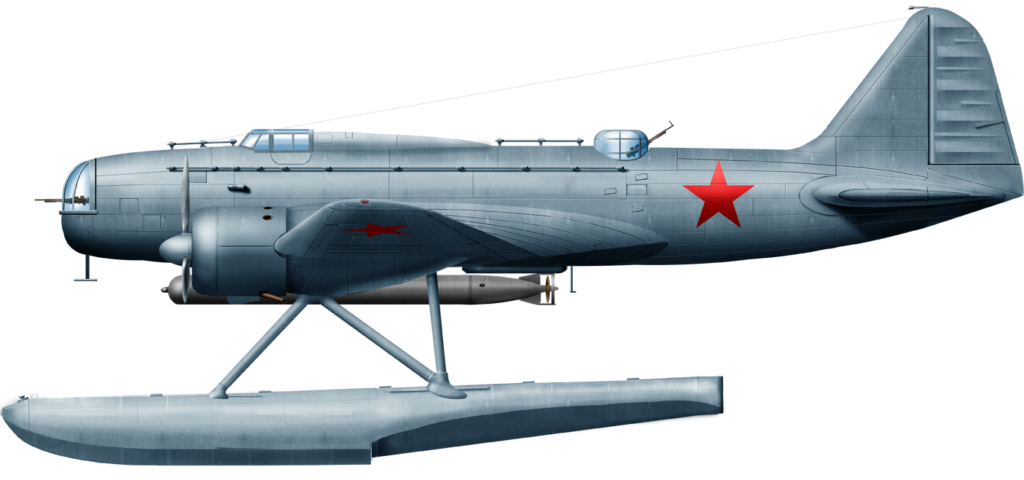
The famous VVS Ilyushin Il-4 was used as a long-range bomber and was also declined into a successful floatplane torpedo-bomber, the DB-4T used by Soviet coastal squadrons. It could carry two regular naval torpedoes, as well as up to 2,700 kg (6,000 lb) of bombs or mines.
 Tupolev MR-6 (1932)
Tupolev MR-6 (1932)
Circa 150 built 1935-37
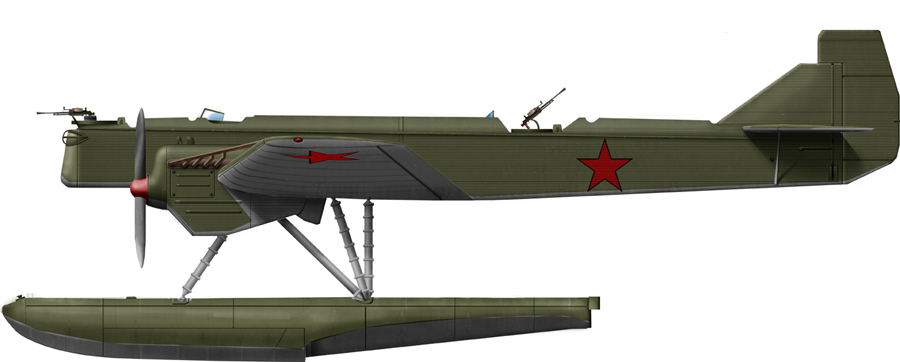
Inspired by Heinkel models, the all-metal cantilever monoplane twin engine reconnaissance Tupolev R-6 was also used by the Navy as the MR-6, equipped with floats. MR-6 stands for Morskoj razvyedchik, maritime reconnaissance (also sometimes called “KR-6P”). It was also used as a torpedo bomber version from 1932 and still used for training in 1939-40. It was retired in 1941 for good. The MP-6 2M-17 was a seaplane passenger transport powered by two 507.1 kW (680 hp) Mikulin M-17 V-12 engines.
 Tupolev MBT-1 (1934)
Tupolev MBT-1 (1934)
15 built 1936-39
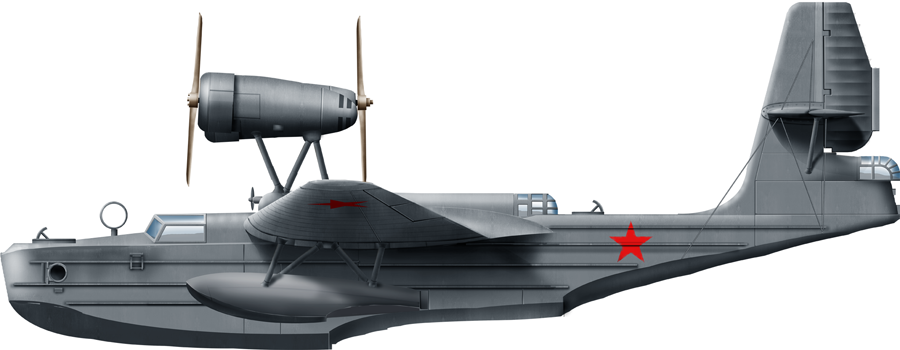
The Tupolev MTB-1 (MDR-4, factory ANT-27) was a patrol flying boat designed as a refined version of the unsuccessful Chyetverikov MDR-3. It kept the MDR-3’s hull, but with a new full-cantilever wing, tail, and engine installation with two tractor and one pusher. The second prototype designated MTB-1 was to be used in a torpedo-carrying role. It was accepted for production before the end of the tests and 15 were produced, remaining in service until 1942.
 Tupolev MBT-2 (1937)
Tupolev MBT-2 (1937)
2 built 1939
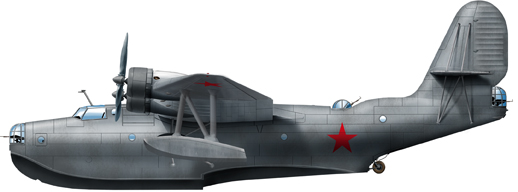
Certainly much more ambitious, the Tupolev MTB-2 was marked as an Heavy Naval Bomber and flying boat (internally ANT-44), with four-engine. Two prototypes were built and performance was good but it was decided to prioritize land-based bombers which could already care for the needs of the Soviet Naval Aviation and it was cancelled in 1940. However the second prototype fought and served actively in WW2 in the black sea.
Land-based Soviet naval aircraft:

Tupolev R-6 of a pacific squadron, 1939
One of the remaining R-6 of the land-based coastal squadrons still used for training and patrols in 1939-40. It was retired in 1942.

Tupolev TB-1 used for training in 1939

Ilyushin DB-4 used by the coast guard

Tupolev ANT-9 Naval transport plane

Yakovlev UT-1 navy trainer

Polikarpov I-16-24 Genadi Tsokolaiev 4th GIA Baltic Fleet, Lake Ladoga April 1942

I-16-24 Boris F. Sapanov 72 SAP Northern Fleet Summer 1941

Mig-3 of the Northern Fleet, deployed as escort of torpedo-bombers or special reconnaissance squadrons.

P-40 of the Northern Fleet, part of lend-lease supplies. Note the unique light blue livery.


 Latest Facebook Entry -
Latest Facebook Entry -  X(Tweeter) Naval Encyclopedia's deck archive
X(Tweeter) Naval Encyclopedia's deck archive Instagram (@navalencyc)
Instagram (@navalencyc)





 French Navy
French Navy Royal Navy
Royal Navy Russian Navy
Russian Navy Armada Espanola
Armada Espanola Austrian Navy
Austrian Navy K.u.K. Kriegsmarine
K.u.K. Kriegsmarine Dansk Marine
Dansk Marine Nautiko Hellenon
Nautiko Hellenon Koninklije Marine 1870
Koninklije Marine 1870 Marinha do Brasil
Marinha do Brasil Osmanlı Donanması
Osmanlı Donanması Marina Do Peru
Marina Do Peru Marinha do Portugal
Marinha do Portugal Regia Marina 1870
Regia Marina 1870 Nihhon Kaigun 1870
Nihhon Kaigun 1870 Preußische Marine 1870
Preußische Marine 1870 Russkiy Flot 1870
Russkiy Flot 1870 Svenska marinen
Svenska marinen Søværnet
Søværnet Union Navy
Union Navy Confederate Navy
Confederate Navy Armada de Argentina
Armada de Argentina Imperial Chinese Navy
Imperial Chinese Navy Marinha do Portugal
Marinha do Portugal Mexico
Mexico Kaiserliche Marine
Kaiserliche Marine 1898 US Navy
1898 US Navy Sovietskiy Flot
Sovietskiy Flot Royal Canadian Navy
Royal Canadian Navy Royal Australian Navy
Royal Australian Navy RNZN Fleet
RNZN Fleet Chinese Navy 1937
Chinese Navy 1937 Kriegsmarine
Kriegsmarine Chilean Navy
Chilean Navy Danish Navy
Danish Navy Finnish Navy
Finnish Navy Hellenic Navy
Hellenic Navy Polish Navy
Polish Navy Romanian Navy
Romanian Navy Turkish Navy
Turkish Navy Royal Yugoslav Navy
Royal Yugoslav Navy Royal Thai Navy
Royal Thai Navy Minor Navies
Minor Navies Albania
Albania Austria
Austria Belgium
Belgium Columbia
Columbia Costa Rica
Costa Rica Cuba
Cuba Czechoslovakia
Czechoslovakia Dominican Republic
Dominican Republic Haiti
Haiti Hungary
Hungary Honduras
Honduras Estonia
Estonia Iceland
Iceland Eire
Eire Equador
Equador Iran
Iran Iraq
Iraq Latvia
Latvia Liberia
Liberia Lithuania
Lithuania Mandchukuo
Mandchukuo Morocco
Morocco Nicaragua
Nicaragua Persia
Persia San Salvador
San Salvador Sarawak
Sarawak Uruguay
Uruguay Venezuela
Venezuela Zanzibar
Zanzibar Warsaw Pact Navies
Warsaw Pact Navies Bulgaria
Bulgaria Hungary
Hungary

 Bundesmarine
Bundesmarine Dutch Navy
Dutch Navy Hellenic Navy
Hellenic Navy Marina Militare
Marina Militare Yugoslav Navy
Yugoslav Navy Chinese Navy
Chinese Navy Indian Navy
Indian Navy Indonesian Navy
Indonesian Navy JMSDF
JMSDF North Korean Navy
North Korean Navy Pakistani Navy
Pakistani Navy Philippines Navy
Philippines Navy ROKN
ROKN Rep. of Singapore Navy
Rep. of Singapore Navy Taiwanese Navy
Taiwanese Navy IDF Navy
IDF Navy Saudi Navy
Saudi Navy Royal New Zealand Navy
Royal New Zealand Navy Egyptian Navy
Egyptian Navy South African Navy
South African Navy






























 Ukrainian Navy
Ukrainian Navy dbodesign
dbodesign